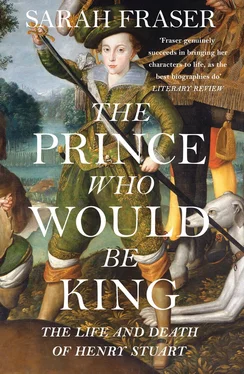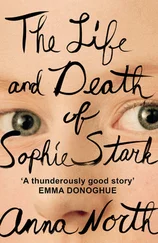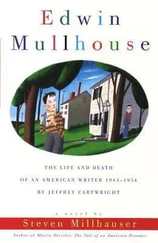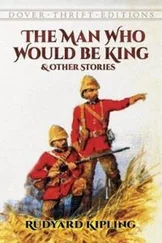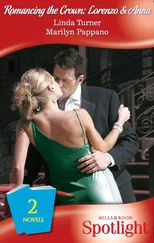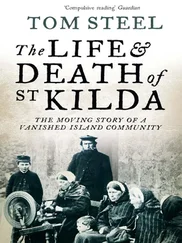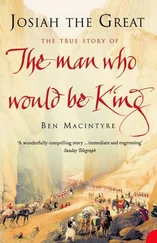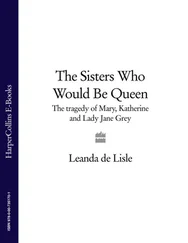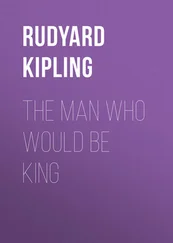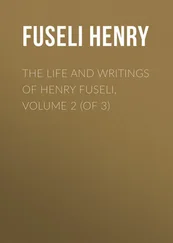Sarah Fraser - The Prince Who Would Be King - The Life and Death of Henry Stuart
Здесь есть возможность читать онлайн «Sarah Fraser - The Prince Who Would Be King - The Life and Death of Henry Stuart» — ознакомительный отрывок электронной книги совершенно бесплатно, а после прочтения отрывка купить полную версию. В некоторых случаях можно слушать аудио, скачать через торрент в формате fb2 и присутствует краткое содержание. Жанр: unrecognised, на английском языке. Описание произведения, (предисловие) а так же отзывы посетителей доступны на портале библиотеки ЛибКат.
- Название:The Prince Who Would Be King: The Life and Death of Henry Stuart
- Автор:
- Жанр:
- Год:неизвестен
- ISBN:нет данных
- Рейтинг книги:3 / 5. Голосов: 1
-
Избранное:Добавить в избранное
- Отзывы:
-
Ваша оценка:
- 60
- 1
- 2
- 3
- 4
- 5
The Prince Who Would Be King: The Life and Death of Henry Stuart: краткое содержание, описание и аннотация
Предлагаем к чтению аннотацию, описание, краткое содержание или предисловие (зависит от того, что написал сам автор книги «The Prince Who Would Be King: The Life and Death of Henry Stuart»). Если вы не нашли необходимую информацию о книге — напишите в комментариях, мы постараемся отыскать её.
NOW THE SUBJECT OF BBC2 DOCUMENTARY The Best King We Never Had
The Prince Who Would Be King: The Life and Death of Henry Stuart — читать онлайн ознакомительный отрывок
Ниже представлен текст книги, разбитый по страницам. Система сохранения места последней прочитанной страницы, позволяет с удобством читать онлайн бесплатно книгу «The Prince Who Would Be King: The Life and Death of Henry Stuart», без необходимости каждый раз заново искать на чём Вы остановились. Поставьте закладку, и сможете в любой момент перейти на страницу, на которой закончили чтение.
Интервал:
Закладка:
Chaloner had grown up with Cecil at the intellectual, godly college set up by Cecil’s father, the great statesman Lord Burghley. Cecil knew what a great house should look like, and how it should run. Chaloner shared the contemporary obsession with alchemy and chemistry; he maintained a good friendship with the magus John Dee, and corresponded with the Dutch inventor, Cornelius Drebbel, encouraging him to come to England and have Henry patronise him. Chaloner’s scientific endeavours would lead to the discovery of alum on his estate in Yorkshire. He obtained a licence to exploit the mineral, which was widely used in shaving, to treat sores and halitosis, to make glues, and in the purification of water.
Chaloner married Elizabeth, daughter of the late William Fleetwood, Queen Elizabeth’s Recorder of London. Chaloner’s father-in-law had been a Puritan-inclined MP. A committed royalist, Fleetwood nevertheless upheld the place of Parliament against Crown encroachments on its powers, citing Magna Carta to prove his case. Like his Fleetwood in-laws, Chaloner inclined to a more godly Protestantism than James would have liked. He understood the chance fortune had just handed the Chaloners, to build up a base among those jockeying for a place around the heir. He persuaded the king and Cecil to appoint his brother-in-law, Thomas Fleetwood, into Henry’s service as the prince’s solicitor. He encouraged Henry’s cofferer, David Foulis to marry Cordelia, another Fleetwood daughter.
Before he entered royal service, Chaloner had fought in France under Leicester, the ‘Captain-General of the Puritans’. He had tutored Leicester’s illegitimate son, Robert Dudley, and worked as an agent in France and Italy for the 2nd Earl of Essex. Chaloner brought all this experience to his new job.
Something about the prince’s first British entourage recalled the heyday of Elizabethan Protestant internationalism in the 1580s and ’90s, under Leicester, Sidney and Essex, with the group’s ‘militarised ideal of active citizenship … which emphasised the rewards of honour through virtuous service’ to the monarch and commonwealth. It seemed that Henry would soon be drinking in the heady brew of an honour cult of old blood, ceremony and magnificence, blended with humanism, Puritan-leaning religious and political values, and a pronounced martial bent. This was always likely given the character of Henry’s Scottish household, and the Scots who had accompanied him to England.
Time would tell. In the first instance though, Nonsuch was a boys’ home. The prince needed a clutch of new friends to grow up with, the best advancing him to help him rule in God’s good time. On his way south from Scotland, James had embraced Robert Devereux, son of the executed Essex, greeting him as ‘the eternal companion of our son’, and restoring the Essex title to him. The young earl had carried James’s sword during the official entry to London and was now sent to live with Henry. The king confirmed Cecil’s son, William Cecil’s, place here. Newton’s new young brother-in-law, Thomas Puckering, also gained admission.
Two of Chaloner’s five boys, William and Edward, stayed. Two other Chaloners, Thomas and James, came and went continually, joining in the hunts, martial exercises, the equestrian training and dancing. Lord Treasurer Dorset’s grandson, Thomas Glenham, came with Dorset’s nephew, Edward Sackville, arriving shortly after. Thomas Wenman appeared with his luggage trunks and tutor (Wenman’s uncle, Sir George Fermor, a veteran of Cádiz 1596, had hosted the king a few months earlier at Easton Neston). The aristocratic and the more favoured boys were educated with Henry. Others became retainers, halfway between servant and friend.
Queen Anne managed to insert into the prince’s household the relatives of her favourite ladies-in-waiting, Lucy Bedford and Penelope Rich. Lady Rich was the 3rd Earl of Essex’s aunt. Lucy Bedford’s brother, John Harington, son of Princess Elizabeth’s guardians, was sent to Henry. Against the king’s wishes, the queen appointed the nephew and heir of the late Earl of Leicester, Sir Robert Sidney, to be her Lord High Chamberlain and Surveyor General. Robert Sidney’s late brother was the poet and Puritan soldier, Sir Philip Sidney. Robert Sidney’s son came to live with Henry. Sidney and young Essex were cousins by marriage. (The 2nd Earl of Essex had married Philip Sidney’s widow.) Though Henry’s new family contained many different surnames, a dense mesh of blood, religion, and politics connected them beneath the skin.
Through these boys, Anne acquired a constant stream of news and contact with her son when she desired it. Since Henry’s household communicated continually with the king, Anne could also tap into the real heart of power: her husband’s court at Whitehall. Henry went ‘often to visit’ his mother, to ‘show his humble and loving duty towards Her Majesty’. Sometimes the queen might be busy and not admit him: he would wait ‘a long time, in vain’, before returning disappointed to his palace.
At other times, mother and son spent weeks at a time in each other’s company. In the summer of 1605, Anne and Henry stopped at Oxford on a summer progress in order to meet with the king and enrol Henry at Magdalen College. Anne and Henry watched plays and listened to music together. At the university Henry attended debates on a bewildering range of subjects, including: ‘Whether saints and angels know the thoughts of the heart’; and the political problem of ‘Whether a stranger and enemy, being detained in a hostile port by adverse winds, contrary to what had been before stipulated in a truce, may be justly killed by the inhabitants of that place’. Students and academics debated ‘Whether gold can be made by art?’ – touching on the alchemical question. Another day, the psychologically curious issue of ‘whether the imagination can produce real effects’ was discussed in its relationship to mind over matter, fantasies, and questions about the real power of magic, charms, spells, and dreams.
In the early days of Henry’s new life in England, a painting appeared that captured its general ambience. It is a hunting picture. Henry stands centre canvas, a friend kneels by him, with the prince caught in the act of drawing his sword from his scabbard. A stag lies by Henry’s feet, neck exposed for the crisis of the kill. The artist, Robert Peake, made two versions. It was the first ever painting to give a glimpse of a royal in action. In one version, John Harington looks up at Henry. In the other, it is young Essex. The king was devoted to the hunt, so he would have liked the ostensible subject. Yet, the boys’ clothes are the green-and-white livery colours of the Tudors, not the red-and-white of the Stuarts. In the centre of the painting, Henry’s St George Garter badge dangles at his chest, capturing the prince as a Protestant knight, prepared to kill for his cause. By contrast, his father’s portraits showed a regal, peaceful sovereign. James never liked to be immortalised in arms.
Many of Henry’s new friends arrived with their own private tutors. Dr Gurrey accompanied Essex; James Cleland, Scotsman and friend of Adam Newton, taught John Harington; Mr Bird tutored young Sidney, until Sidney stabbed his tutor, and both had to leave – the boy’s father apologising profusely to the king and queen. Thomas Wenman’s tutor was the poet William Basse. Huguenot immigrant, friend of Ben Jonson and Francis Beaumont, Basse collaborated with Shakespeare. They came across each other during their attendance on prince and king, as well as in the greater world outside palace walls.
In the schoolroom, Chaloner employed Peter Bales to give Henry a neat hand. Bales taught Henry for nearly two years before he dared petition Cecil for remuneration. A former Essexian, his unpaid service worked his passage back into favour. The Earl of Rutland introduced Robert Dallington as another unpaid tutor, who might be given a wage if he made himself useful for long enough. A brilliant scholar, Dallington had been imprisoned by Elizabeth I, along with Rutland and Bales, in 1601 when they rose with Essex. These floating tutors, along with various senior aristocrats, would be able to educate Henry’s whole person about his role and his history.
Читать дальшеИнтервал:
Закладка:
Похожие книги на «The Prince Who Would Be King: The Life and Death of Henry Stuart»
Представляем Вашему вниманию похожие книги на «The Prince Who Would Be King: The Life and Death of Henry Stuart» списком для выбора. Мы отобрали схожую по названию и смыслу литературу в надежде предоставить читателям больше вариантов отыскать новые, интересные, ещё непрочитанные произведения.
Обсуждение, отзывы о книге «The Prince Who Would Be King: The Life and Death of Henry Stuart» и просто собственные мнения читателей. Оставьте ваши комментарии, напишите, что Вы думаете о произведении, его смысле или главных героях. Укажите что конкретно понравилось, а что нет, и почему Вы так считаете.
